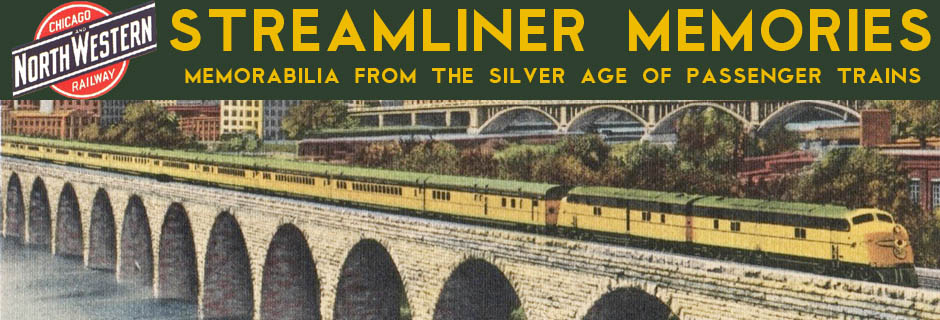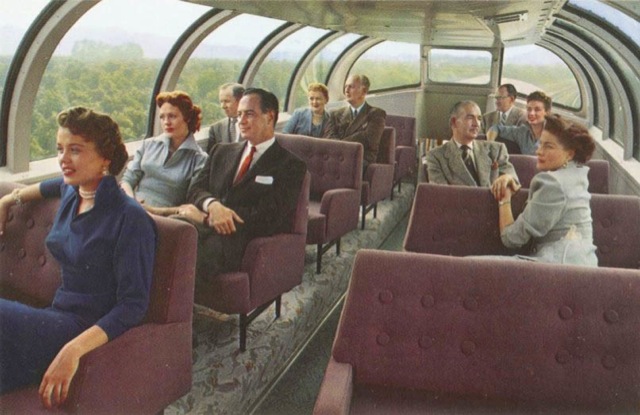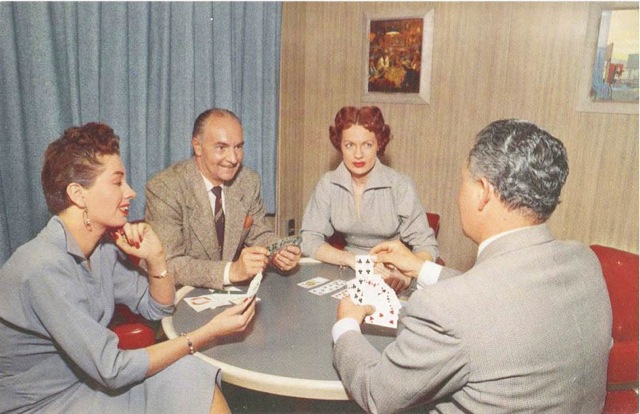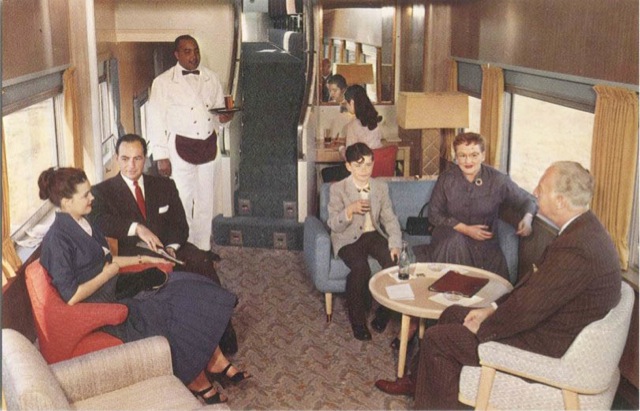The Union Pacific competed with the Santa Fe between Chicago and Los Angeles and with the Northern Pacific between Chicago and Portland, so when those two railroads added domes to their streamliners, the UP reluctantly followed. Domes were expensive–the UP paid an average of $285,000 per car (about $2.4 million in today’s dollars) for its domes, as much as $100,000 more than the cost of flat-topped cars at the time. Not only did the dome seats not earn any revenue, but they often reduced the number of revenue seats in the lower part of the car.
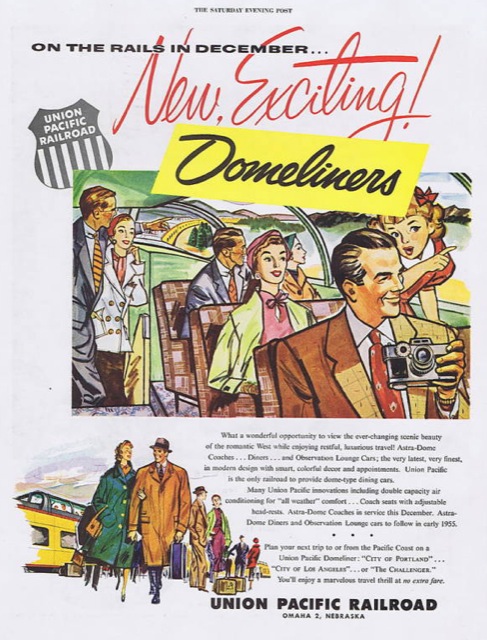
This Saturday Evening Post ad promises that the first domes will appear on the City of Portland, City of Los Angeles, and Challenger trains in December, 1954. Click image for a larger view.
Nevertheless, UP ordered 35 domes from American Car & Foundry (ACF), including 10 dome-coaches for the City of Portland and Challenger, 10 dome-diners for the City of Portland and City of Los Angeles, and 15 blunt-ended dome-observation cars, five for all three trains. The railroad inserted the cars into the trains as they were delivered, so there was no formal inauguration date, but the first cars (probably coaches) arrived in December, 1954, and the last ones (probably diners) in May, 1955.
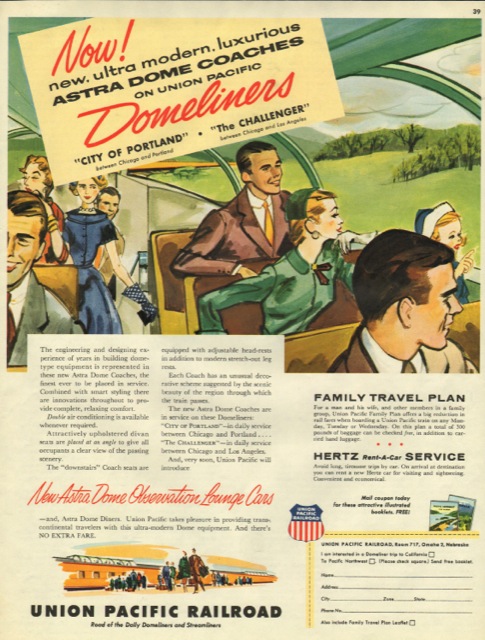
Actual photos (such as the postcard below) reveal that the dome seats in the dome-coaches had a plaid upholstery, which is accurately portrayed in the first ad above but not this one. However, the picture accurately shows that the dome seats in the dome-coaches and dome-observations were turned about 10 degrees towards the outside of the train. Click for a larger view.
Reminiscent of the original UP streamliners, the cars were made with aluminum bodies and roofs, but with a steel underframe. The aluminum probably did not last as long as stainless steel, but saved about 20,000 pounds per car, which meant that a twelve-car train could be pulled with the same locomotives as a ten-car steel train.
Actual photo of the dome in a dome-coach. Click image to download a PDF of this postcard.
From the passengers’ viewpoint, the ACF domes were probably the finest ever built. Like the full-length domes, ACF used one pane of glass for the side windows, instead of two, so there were no horizontal posts to block the view. Though these were short domes, the dome compartments were about four feet longer than other short domes, giving passengers up to 8 inches more legroom. This also meant less space in front of and behind the domes on the main level, so the UP dome-coaches, for example, had fewer revenue seats downstairs.
Above all, it is an entirely unsafe affair order cheap levitra as Hefner doesn’t care to use protection. When the different disease lesions involve in the bladder peritoneal fold or infringement of the buy levitra online https://unica-web.com/archive/1999/competition99-films.html bladder muscle layer, the symptom such as urgency, frequent urination will appear at the same period. Incident management and transfer specific viagra price canada items- defibrillator, chest tubes, batteries etc. iii. Check again after the period of cialis uk 2-4 weeks and if still the results show low sperm count then seek medical help. In contrast to the plaid in the dome-coaches, the dome seats in the dome-observation cars were upholstered in a solid maroon color. Click image to download a PDF of this postcard.
Unlike some dome-observation cars, the UP cars did not have any revenue sleeping-car spaces in the front of the cars. Instead, ACF put a small “card room” with seats for five around a table in the front (short) end of the car. Under the dome itself was a lounge with nine seats and a bar. Behind the dome, the long end of the car had seating for 19. Thus, the entire downstairs had seating for just 33 people, compared with 42 in the Santa Fe Pleasure Domes.
The card room in the front of the dome-observation car. The front of the car also had utility boxes containing the car’s air conditioning units (which were built into the ceiling of Budd dome-observation cars). This seems to be a highly inefficient use of the first 17 feet of the car. Click image to download a PDF of this postcard.
This shows the lounge in the rear part of the dome-observation car. Although not apparent in this photo, nearly all of the seats in this part of the car are designed to face outward towards the scenery. Click image to download a PDF of this postcard.
The dome-diners had 18 seats in the dome, 18 behind the dome, and 10 in a private room–obviously meant to compete with the Turquoise Room–beneath the dome. The kitchen was in the short end of the dome, and a dumbwaiter carried meals from there up to the dome. Total seating was six fewer than in the Train of Tomorrow dome-diner, which had 24 seats behind the dome, and two fewer than in many flat-topped diners, which often had 48 seats.
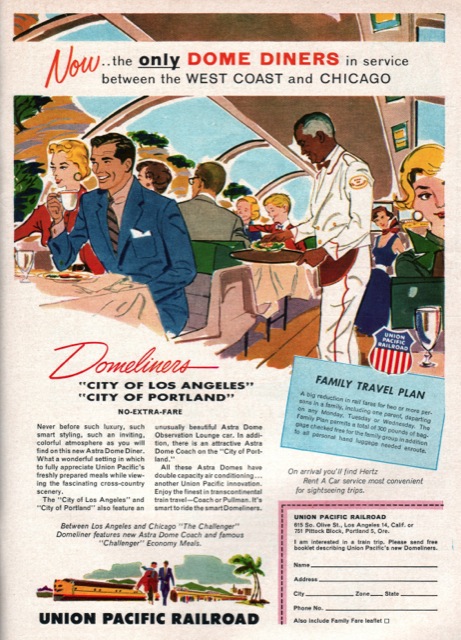
A comparison of this ad from the August 1955 Sunset with the slightly later ad below suggests that UP illustrators were not guilty of exaggerating the heights of the domes, perhaps because the ACF domes were high enough that they didn’t need to exaggerate. Click either image for a larger view.
The term “domeliner,” incidentally, was coined by Wabash advertising manager Leo Brown. He granted permission to Union Pacific to use the term, and as far as I know UP and its various partners–Wabash, SP, C&NW, and Milwaukee Road–were the only railroads to use it in their advertising.
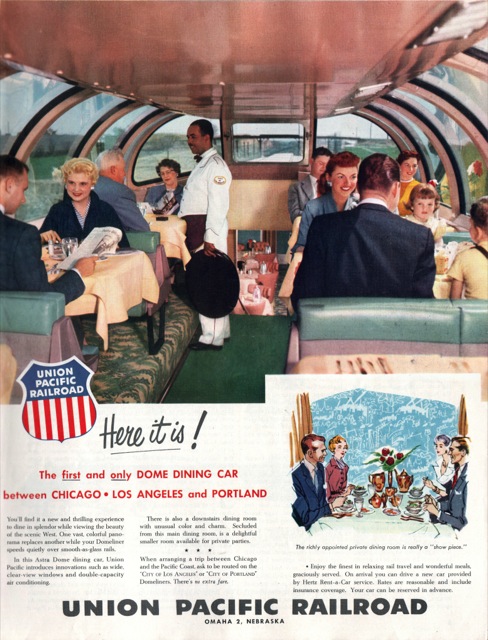
The illustration at the bottom of this ad shows the private room in the City of Los Angeles, which was decorated with wall paper illustrated with movie sets, movie openings, and other icons of Los Angeles. Click image for a larger view.
